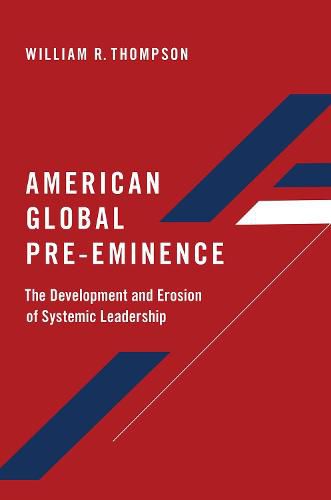Readings Newsletter
Become a Readings Member to make your shopping experience even easier.
Sign in or sign up for free!
You’re not far away from qualifying for FREE standard shipping within Australia
You’ve qualified for FREE standard shipping within Australia
The cart is loading…






A unique analysis that assesses how we can determine which country will be the next world leader. Will China surpass the United States as the world’s leader? In American Global Pre-eminence, William R. Thompson argues that the answer depends on leads in technological innovation, energy, and global reach. These are the forces that influence the hierarchy of global power–a system which began emerging a thousand years ago and started becoming more evident after the 1490s, especially after Dutch activities in the seventeenth century and British operations in the nineteenth century. The US followed in this fashion after 1945. Yet leads do not last forever. Ironically, as it becomes clearer how technological innovation, military force, and energy power interact, the processes under scrutiny may themselves be fundamentally transforming. Thus, Thompson contends, the real policy question is not whether the US is ahead or behind China but, rather, whether it will remain possible for a single state to lead the global system. As technological innovation, energy consumption, and global reach capability grow less concentrated, the prospects for systemic leadership shrink–even as global problems become more complex and acute. With a sweeping analysis of global power, Thompson provides a foundation for understanding the realities and possibilities of lead states past, present, and future.
$9.00 standard shipping within Australia
FREE standard shipping within Australia for orders over $100.00
Express & International shipping calculated at checkout
A unique analysis that assesses how we can determine which country will be the next world leader. Will China surpass the United States as the world’s leader? In American Global Pre-eminence, William R. Thompson argues that the answer depends on leads in technological innovation, energy, and global reach. These are the forces that influence the hierarchy of global power–a system which began emerging a thousand years ago and started becoming more evident after the 1490s, especially after Dutch activities in the seventeenth century and British operations in the nineteenth century. The US followed in this fashion after 1945. Yet leads do not last forever. Ironically, as it becomes clearer how technological innovation, military force, and energy power interact, the processes under scrutiny may themselves be fundamentally transforming. Thus, Thompson contends, the real policy question is not whether the US is ahead or behind China but, rather, whether it will remain possible for a single state to lead the global system. As technological innovation, energy consumption, and global reach capability grow less concentrated, the prospects for systemic leadership shrink–even as global problems become more complex and acute. With a sweeping analysis of global power, Thompson provides a foundation for understanding the realities and possibilities of lead states past, present, and future.